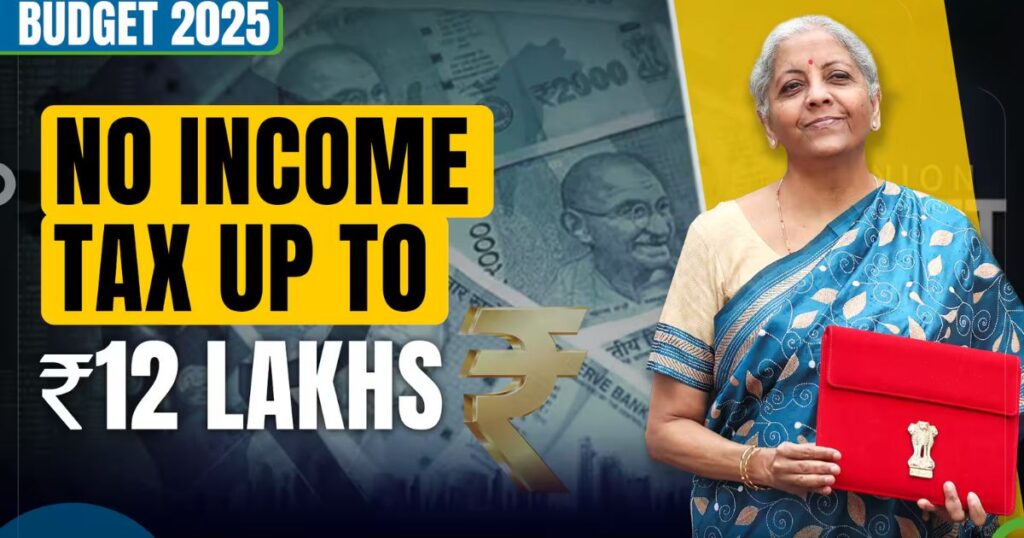Budget 2025: No Income Tax Upto ₹12 Lakhs Explained
The buzz around the Union Budget is always significant, and Budget 2025 is no different. Among the various discussions and speculations, one particular claim has caught the attention of many taxpayers: the idea of no income tax upto 12 lakhs. As India navigates the financial year 2024-25 (Assessment Year 2025-26), understanding the actual tax implications is crucial for both personal finance management and business planning. This post aims to dissect this widely circulated claim, clarify the real budget 2025 income tax updates, and explain the applicable income tax rules. Whether you are a salaried individual carefully planning your investments or a small business owner managing finances, knowing the correct tax structure is vital. Let’s explore what Budget 2025 truly means for your tax liability.
Is There Really “No Income Tax Upto ₹12 Lakhs” After Budget 2025?
Let’s address the burning question directly: Did Budget 2025 officially announce a blanket rule stating no income tax upto 12 lakhs? The simple answer is no. There has been no such official announcement from the Finance Ministry implementing a universal tax exemption up to ₹12 lakhs for all taxpayers for the Financial Year 2024-25 (Assessment Year 2025-26). So, where does this figure come from, and why is it gaining traction in income tax news budget 2025? The origin likely lies in a misunderstanding or specific interpretation of existing tax rules, particularly concerning the interplay between the Old and New Tax Regimes.
The most probable source of confusion is the New Tax Regime and the tax rebate offered under Section 87A. Under the current New Tax Regime (which is the default regime unless you opt out), individuals with a net taxable income up to ₹7 lakhs end up paying zero tax due to this rebate. This ₹7 lakh threshold is often misquoted or perhaps optimistically stretched in casual discussions. Another possibility is that for certain individuals opting for the Old Tax Regime, by claiming numerous deductions and exemptions (like HRA, standard deduction, Section 80C, 80D, home loan interest, etc.), it might be mathematically possible to bring their taxable income down significantly, even if their gross income is around ₹12 lakhs. However, this is highly conditional and depends entirely on the specific deductions an individual is eligible for and claims; it is not a standard rule or a general budget 2025 income tax updates. The official income tax exemption limit 2025 under the Old Regime remains lower (₹2.5 lakhs or ₹3 lakhs depending on age), and the New Regime focuses on the rebate mechanism. Always rely on official government notifications or trusted sources like the Income Tax Department website for accurate information.
Overview of Income Tax Slabs Post-Budget 2025
For the Financial Year 2024-25 (Assessment Year 2025-26), taxpayers in India continue to have a choice between two tax regimes: the New Tax Regime (which is the default) and the Old Tax Regime. Understanding the structure of both is essential to determine your tax liability accurately. Budget 2025 did not introduce major changes to these existing slabs, maintaining the structure established previously. Let’s break down each regime.
The New Tax Regime (Default Regime)
The New Tax Regime was introduced to offer lower tax rates with fewer exemptions and deductions. It has been positioned as the default option, meaning if you don’t explicitly choose the Old Regime, you will be taxed under this structure.
- Income Tax Slabs (FY 2024-25 / AY 2025-26):
- ₹0 to ₹3,00,000: Nil
- ₹3,00,001 to ₹6,00,000: 5%
- ₹6,00,001 to ₹9,00,000: 10%
- ₹9,00,001 to ₹12,00,000: 15%
- ₹12,00,001 to ₹15,00,000: 20%
- Above ₹15,00,000: 30%
- Rebate under Section 87A: A key feature is the tax rebate available for resident individuals whose net taxable income does not exceed ₹7,00,000. This effectively makes income up to ₹7 lakhs tax-free under this regime.
- Standard Deduction: A standard deduction of ₹50,000 is available for salaried individuals and pensioners under the New Tax Regime as well.
- Limited Deductions: Most common deductions like those under Section 80C (EPF, PPF, ELSS, Life Insurance Premium, etc.), Section 80D (Health Insurance Premium), HRA exemption, and interest paid on housing loans (Section 24b) are not available under the New Regime. Employer’s contribution to NPS (Section 80CCD(2)) is one of the few deductions still allowed.
This regime is designed for simplicity, potentially benefiting those who do not make significant tax-saving investments or claim extensive deductions.
The Old Tax Regime (Optional)
Taxpayers still have the option to choose the Old Tax Regime if it proves more beneficial for them. This regime features slightly higher tax rates but allows a wide array of exemptions and deductions.
- Income Tax Slab for Salaried 2025 (and Others) – FY 2024-25 / AY 2025-26:
- For Individuals below 60 years & HUF:
- Up to ₹2,50,000: Nil
- ₹2,50,001 to ₹5,00,000: 5%
- ₹5,00,001 to ₹10,00,000: 20%
- Above ₹10,00,000: 30%
- For Senior Citizens (60 to 80 years): Basic exemption limit is ₹3,00,000.
- For Super Senior Citizens (80 years and above): Basic exemption limit is ₹5,00,000.
- For Individuals below 60 years & HUF:
- Key Deductions & Exemptions: This regime allows taxpayers to claim various deductions and exemptions, including:
- House Rent Allowance (HRA)
- Leave Travel Allowance (LTA)
- Section 80C (up to ₹1.5 lakh for investments like PPF, EPF, ELSS, NSC, life insurance, home loan principal repayment, etc.)
- Section 80D (health insurance premium)
- Section 80G (donations)
- Section 24(b) (interest on housing loan)
- Standard Deduction of ₹50,000 (for salaried/pensioners)
- Basic Exemption Limit: The
income tax exemption limit 2025under the Old Regime is ₹2.5 lakhs for individuals below 60. - Rebate under Section 87A: A rebate is available if the net taxable income does not exceed ₹5,00,000 (lower than the New Regime’s ₹7 lakh threshold).
Choosing the Old Regime usually makes sense for individuals who utilize various tax-saving instruments and claim significant deductions like HRA and home loan interest.
Old Regime vs. New Regime: Making the Right Choice
Deciding between the Old and New Tax Regimes is a crucial financial decision that depends entirely on your individual income profile, spending habits, and investment patterns. There’s no one-size-fits-all answer; what offers better budget 2025 tax benefits for one person might not for another. Comparing both regimes based on your specific financial situation is key. You need to calculate your tax liability under both scenarios before making a final choice for the financial year.
Key Factors to Consider
When comparing the two regimes, several factors come into play:
- Income Level: At different income levels, the slab rates and rebate applicability significantly alter the final tax payable under each regime.
- Investment & Savings Habits: If you consistently invest in instruments eligible under Section 80C, pay health insurance premiums (Section 80D), have a home loan (Section 24b interest deduction), or claim HRA, the Old Regime might be more advantageous due to the availability of these deductions.
- Deduction Quantum: It’s not just about making investments, but the amount you can claim. You need to estimate the total deductions you are eligible for under the Old Regime. Generally, if your total claimed deductions are relatively low (e.g., less than ₹1.5 – ₹2 lakhs), the New Regime’s lower rates might be more beneficial.
- Simplicity vs. Optimization: The New Regime offers simplicity with fewer compliance requirements regarding proof submission for deductions. The Old Regime requires meticulous record-keeping but offers potentially higher tax savings if you maximize eligible deductions.
Scenarios for Salaried Individuals
Let’s consider a couple of examples for salaried employees evaluating the income tax slab for salaried 2025:
- Scenario 1 (High Deductions): An individual earning ₹15 lakhs per annum, claiming ₹1.5 lakhs under 80C, ₹50,000 under 80D, ₹2 lakhs interest on home loan, and ₹1 lakh HRA exemption. In this case, the total deductions significantly reduce the taxable income under the Old Regime, likely making it more beneficial than the New Regime despite its lower rates.
- Scenario 2 (Low/No Deductions): An individual earning ₹10 lakhs per annum with minimal tax-saving investments and no HRA or home loan benefits. Here, the standard deduction of ₹50,000 is available in both regimes. The lower tax rates of the New Regime up to ₹12 lakhs might result in lower overall tax liability compared to the Old Regime’s 20% slab kicking in above ₹5 lakhs.
Implications for Small Business Owners
Small business owners also need to carefully evaluate their choice:
- Business Deductions: While many personal deductions (like 80C) are disallowed in the New Regime, deductions related to business expenditure are generally allowed under both regimes when calculating Profit and Gains from Business or Profession (PGBP).
- Presumptive Taxation: If you opt for presumptive taxation schemes (like Section 44AD or 44ADA), assess how this interacts with your choice of regime. The calculation basis remains largely the same, but the final tax liability depends on the chosen regime’s slab rates applied to the presumptive income. Learn more about presumptive taxation here: Section 44AD: Presumptive Taxation Scheme for Small Businesses.
- Flexibility: Salaried individuals can switch between regimes year-on-year (with some restrictions if they have business income). However, individuals with business income who opt for the New Regime can switch back to the Old Regime only once in their lifetime. After switching back, they cannot opt for the New Regime again. This makes the initial choice more critical for business owners.
Careful calculation and perhaps consultation are advised before finalizing the regime choice.
How to Estimate Your Tax Liability
Calculating your income tax liability accurately is essential for financial planning and meeting compliance requirements. While the process involves several steps, understanding the basics can help you estimate your potential tax outgo for the Assessment Year 2025-26. Using an online income tax calculator 2025 india can simplify this process significantly.
Steps for Calculation
Here’s a basic step-by-step guide to estimating your income tax:
- Determine Gross Total Income (GTI): Sum up your income from all sources – Salary, House Property, Business or Profession, Capital Gains, and Other Sources.
- Choose Your Tax Regime: Decide whether you want to opt for the Old Tax Regime or the New Tax Regime (default). This choice dictates which deductions and tax slabs apply.
- Identify Applicable Deductions/Exemptions:
- If opting for Old Regime: List all eligible deductions like Standard Deduction (if salaried/pensioner), HRA (if applicable), Section 80C, 80D, 80G, Section 24(b) interest on home loan, etc.
- If opting for New Regime: Primarily consider the Standard Deduction (if salaried/pensioner) and deduction under Section 80CCD(2) (employer’s NPS contribution), as most other common deductions are unavailable.
- Calculate Net Taxable Income: Subtract the total applicable deductions from your Gross Total Income (GTI). This is the income on which tax will be calculated.
Net Taxable Income = Gross Total Income – Applicable Deductions - Apply Tax Slab Rates: Use the appropriate
budget 2025 income tax slabrates (corresponding to your chosen regime and income level) to calculate the gross tax amount. For more on tax planning, you may also explore: Top Tax Planning Strategies for Startups and SMEs. - Factor in Rebate (Sec 87A): Check if you are eligible for a rebate under Section 87A.
- New Regime: If Net Taxable Income ≤ ₹7 lakhs, the rebate makes the tax payable zero.
- Old Regime: If Net Taxable Income ≤ ₹5 lakhs, a rebate up to ₹12,500 is available.
- Add Health and Education Cess: Add the applicable Health and Education Cess (currently 4%) to your calculated income tax (after rebate, if any). This gives you the final tax liability.
Using an Income Tax Calculator 2025 India
Manual calculations can be prone to errors, especially when comparing regimes. Using an online income tax calculator is highly recommended.
- Benefits: Calculators automate the application of slab rates, deductions, and rebates, providing quick and accurate estimates for both regimes side-by-side.
- Where to Find: You can find reliable calculators on the official Income Tax Department portal or reputable financial websites. The official calculator can be accessed here: Income Tax India Website. Many financial technology platforms like TaxRobo also offer user-friendly calculators.
- How to Use: Keep details like your gross income, potential deductions (80C investments, HRA details, home loan interest, etc.) handy. Input these details into the calculator, and it will show your estimated tax liability under both the Old and New Regimes, helping you make an informed decision.
Conclusion
Navigating the complexities of India’s income tax system requires clarity, especially amidst swirling rumours like the potential for no income tax upto 12 lakhs following Budget 2025. As we’ve clarified, this specific claim is not based on any official announcement for FY 2024-25. The actual rules hinge on the choice between the Old and New Tax Regimes. The confusion likely stems from the New Tax Regime’s effective tax-free income limit of ₹7 lakhs due to the Section 87A rebate, or potentially from specific scenarios under the Old Regime where high deductions drastically reduce taxable income for some individuals earning near that bracket.
The key takeaway is the importance of understanding the current, official budget 2025 income tax slab structures for both regimes. Salaried individuals and small business owners must carefully evaluate their income sources, investment habits, and eligible deductions to choose the regime that minimizes their tax liability. Using an income tax calculator 2025 india and staying updated with official budget 2025 income tax updates is crucial. Don’t let misinformation guide your financial decisions; rely on facts and calculations. For personalized guidance tailored to your unique financial situation, consider consulting with tax experts. TaxRobo offers comprehensive Income Tax Filing and Tax Planning services to help you optimize your taxes effectively.
Frequently Asked Questions (FAQs) about Budget 2025 Income Tax
Q1: Is income up to ₹12 lakhs completely tax-free after Budget 2025?
Answer: No, there is no official rule making income universally tax-free up to ₹12 lakhs. The claim of no income tax upto 12 lakhs is likely a misinterpretation. Under the New Tax Regime, income is effectively tax-free up to ₹7 lakhs due to the rebate under Section 87A. While someone earning around ₹12 lakhs under the Old Regime might pay zero tax if they claim very high deductions (like HRA, home loan interest, 80C, etc.), this is a specific calculation based on individual circumstances, not a standard exemption limit.
Q2: What is the basic income tax exemption limit 2025?
Answer: The basic exemption limit depends on the chosen tax regime and age:
- Under the Old Tax Regime: It is ₹2.5 lakhs for individuals below 60 years, ₹3 lakhs for senior citizens (60-80 years), and ₹5 lakhs for super senior citizens (above 80 years).
- Under the New Tax Regime: The concept works slightly differently. While the slab starts from ₹3 lakhs (Nil tax up to ₹3 lakhs), the effective tax-free income is ₹7 lakhs due to the Section 87A rebate. There isn’t a separate ‘basic exemption limit’ in the same way as the Old Regime above the ₹3 lakh threshold.
Q3: Should I switch to the New Tax Regime based on Budget 2025 income tax updates?
Answer: Since Budget 2025 largely maintained the status quo regarding tax slabs, the decision depends on your individual financial profile. If you have substantial deductions (like HRA, Section 80C, home loan interest, etc.) that significantly reduce your taxable income under the Old Regime, it might still be more beneficial. If your eligible deductions are low, the New Regime’s lower tax rates might result in less tax payable. It’s best to calculate your tax liability under both regimes or seek professional advice.
Q4: Where can I find the official budget 2025 income tax slab details?
Answer: Official details about income tax slabs, rules, and any updates are always available on the website of the Income Tax Department of India: Income Tax India Website. You can also refer to press releases and notifications issued by the Ministry of Finance. Avoid relying solely on news articles or social media posts for definitive information.
Q5: How can I use an income tax calculator 2025 india effectively?
Answer: To use an income tax calculator effectively:
- Gather all your income details (salary break-up, income from other sources).
- List down all potential deductions and exemptions you are eligible for (investments, insurance premiums, rent paid, home loan details, etc.).
- Input these figures accurately into the calculator for both the Old and New Tax Regimes.
- Compare the final tax liability shown for both options.
- Use the results to decide which regime is more beneficial for you for FY 2024-25 (AY 2025-26). Remember to use a reliable calculator, preferably from the official Income Tax portal or trusted financial service providers like TaxRobo.



